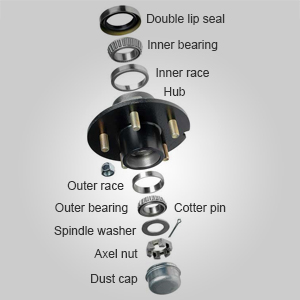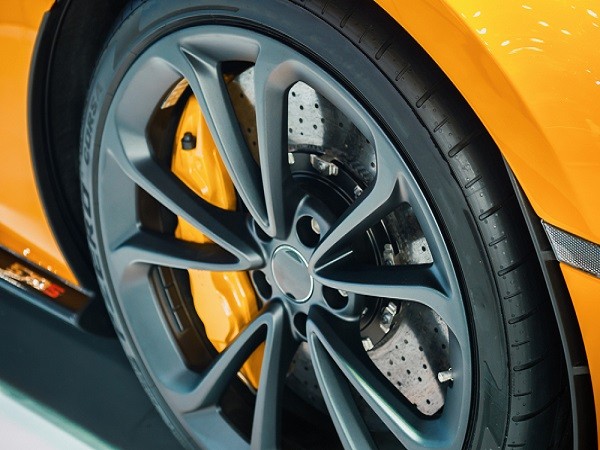There are two types of bearings: hub and wheel. Both use the same physical characteristics of bearings, as the bearing balls they contain are lubricated for rotation to allow the wheels to rotate. One major difference between the two is how they are assembled. Wheel bearings can be removed, lubricated and reassembled for reuse. Hub bearings are pre-packed at the manufacturer's plant and sold and installed as a complete unit. These cannot be separately relubricated but must be replaced.
Diagnosing Wheel Hub Bearing Issues
Diagnosing car troubles by sound alone is an inexact science, but you should not ignore new or unusual car noises. According to oft-cited studies by Braxton Research, 51% of wheel bearing problems are caused by noise (24% found during braking and 19% during alignment).
That being said, although noise from bad hub assemblies and/or wheel bearings comes from your wheel area, not all strange sounds from your wheel area are related to assembly or bearings. They may indicate a problem with your brake or CV joints. If the noise changes as the brakes are applied, the problem is more likely to be related to the brakes.
Still, be sure to check your hub assembly and wheel bearings if you hear:
Chirping, squealing or grinding sounds with different intensities at different speeds. These noises may get louder or softer upon turning.
Humming that exists when you drive and increases when you start to turn your steering wheel
If you ever sense a vibration from your wheels or your wheels “wobble” be sure to check your hub assembly and wheel bearings.

Other symptoms include:
Snapping, clicking or popping.
This can indicate a worn or damaged outer CV-joint. However, it also can be related to excessive bearing endplay, usually associated with inadequate clamping. This noise is typically heard when cornering or making sharp turns.
Grinding when the vehicle is in motion.
Typically, this means there is mechanical damage in a wheel-end system. Related to a bearing, it means a loss of integrity such as roller or raceway damage. The noise is normally heard when turning or when there is a shift in load.
Knocking or clunking.
This can signal excessive play in the CV-joints or U-joints. It also can be caused by excessive backlash in the differential gears. This is not generally associated with bearings and is normally heard either when shifting from changing directions, such as from forward to reverse or transitioning from accelerating to coasting.
Humming, rumbling or growling.
These noises are normally associated with tire, electrical or drivetrain components. If bearing-related, the noise or vibration is present when driving in a straight line, but intensifies when turning the steering wheel slightly to the left or right. Typically, the side opposite the rumbling is the defective side.
Wheel vibration and/or wobble.
This is generally associated with a damaged or worn tire, wheel or suspension component or severe chassis misalignment. When related to the hub or bearing, this normally indicates the loss of clamp or a bearing with extreme mechanical damage. It also can occur when lug nuts are not properly torqued.
Shudder, shimmy or vibration at a constant speed.
This is normally associated with worn or damaged suspension components or tires that are out-of-balance or out-of-round. It is not normally indicative of hub or bearing damage.
Abnormal side pull when brakes are applied.
This is normally indicative of a defective calliper or equalizer, but it also can be a sign of worn brakes or rotors. However, severe looseness related to a bearing can also cause excessive run out, which may cause the brakes to pulsate or pull. The most common cause is a warped rotor due to the calliper not retracting.

Uneven rotor or brake pad wear.
This is normally indicative of a bad calliper and/or a bad equalizer, which is not bearing-related. Severe looseness related to a worn or damaged bearing can cause excessive run out, which can cause uneven wear on the brake pads and/or rotor. The most common cause is a warped rotor due to the calliper not retracting.
Abnormal or uneven tyre wear.
There are many causes of abnormal tire wear. The most common are worn or damaged suspension components, misalignment, improper inflation or tire selection. While extreme bearing wear or looseness can cause abnormal tire wear, it is typically related to other failure modes.
ABS failure, which could be internal or external to the bearing or hub bearing assembly.
In extreme cases, internal and external sensors can be damaged from excessive movement caused by too much end-play. This indicates a lack or loss of bearing clamp. This normally results from severe mechanical break up or damage. (Additionally, in designs where the sensor is mounted externally, sensor damage can result from corrosion, stones and other hazards.)
Diagnosing Wheel bearing Issues
Most wheel bearings are hardened steel and can withstand a lot of abuse. Its two worst enemies are heat and water. Heat caused by lack of lubrication can destroy a wheel bearing. Water that penetrates a sealed bearing will also destroy it.
Most wheel bearings manufactured today are sealed. They come from the factory pressed together as an assembly: front race, bearing set, centre race, bearing set, and outer race, with seals on both the front and rear. Seals protect bearings from elements, water and debris, and seal high temperature greases needed by bearings. When the seals break or are damaged, the wheel bearings fail and begin to make noise.
Pinpointing the Source of Bearing Noise
If you really want to know whether your noise is a bearing noise and you can get the car up on a lift, you can use a makeshift stethoscope (actually a large screwdriver) to listen for the sound and find out where it's coming from. Get someone in the car to start and go 40 miles. Using a long screwdriver or stethoscope, place it on the hub near each wheel bearing. Be careful! Do not let the tool touch a moving part or it may fly up and hit you. By listening to the noise through the handle of a screwdriver (or through a stethoscope), you can determine which bearing is broken.













